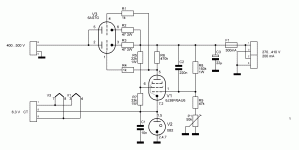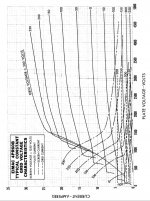Hello!
I'm looking for a simple-ish, stable regulated vacuum tube based (silicon diodes for the rectifier and no zeners, for stability reasons) 0 to 250V bench power supply schematic.
I have 3 different input power supplies (one 300V and two 330V, all isolated) and separate PSUs for the heaters and stuff.
I have a few different kinds of tubes:
One 12AX7
Two 6AQ5
Two PCL85
Exotic tubes:
One TM-85 pulse tetrode with a max dissipation of 60W, similar to 8252
One 2C39A triode with a max dissipation of 100W
Cold-cathode voltage regulator:
VR-150
I am looking for peak current availability of about 0.5A, which both of my "exotic" tubes can handle.
Cooling the 2C39A is also not a problem, even at close to 100W of plate dissipation.
I have tried to build the Heathkit IP-32 with different values and a PCL85 and a 6AQ5 and trying to eliminate one of the regulator/refrence tubes, but it just doesn't work well.
Thank you!
I'm looking for a simple-ish, stable regulated vacuum tube based (silicon diodes for the rectifier and no zeners, for stability reasons) 0 to 250V bench power supply schematic.
I have 3 different input power supplies (one 300V and two 330V, all isolated) and separate PSUs for the heaters and stuff.
I have a few different kinds of tubes:
One 12AX7
Two 6AQ5
Two PCL85
Exotic tubes:
One TM-85 pulse tetrode with a max dissipation of 60W, similar to 8252
One 2C39A triode with a max dissipation of 100W
Cold-cathode voltage regulator:
VR-150
I am looking for peak current availability of about 0.5A, which both of my "exotic" tubes can handle.
Cooling the 2C39A is also not a problem, even at close to 100W of plate dissipation.
I have tried to build the Heathkit IP-32 with different values and a PCL85 and a 6AQ5 and trying to eliminate one of the regulator/refrence tubes, but it just doesn't work well.
Thank you!
Search in the page "americanradiohistory.com" for voltage regulators in the red section, you will find lots of such stuff. I did such a research weeks ago. Perhaps one of them can be adapted to be used with your tubes.
Search in the page "americanradiohistory.com" for voltage regulators in the red section, you will find lots of such stuff. I did such a research weeks ago. Perhaps one of them can be adapted to be used with your tubes.
OK, I'll check it out.
Thanks!
Enjoy!
If by red section you meant the technical section, I couldn't find anything useful relating tube power supplies 🙁
I found a few fun circuits though.
OK, try again with "Hunt and Hickman" and "On Electronic Voltage Stabilizer". They create a lots of regulators´ theory around 1939 and has been source of inspiration for many future works in the following years. If you want I can send a pdf copy of the original paper.
Could you please send me the PDF? It'd be awesome.OK, try again with "Hunt and Hickman" and "On Electronic Voltage Stabilizer". They create a lots of regulators´ theory around 1939 and has been source of inspiration for many future works in the following years. If you want I can send a pdf copy of the original paper.
Thanks!
Send me a email to lw1dseATgmailDOTcom or lw1dseATyahooDOTcom. I will be glad to share the info. Unfortunately there are missing pages, but for most reading it suffices.
no zeners, for stability reasons)
Huh? Care to explain what you mean by that?
Jan
Well, zeners drift a lot with temperature. Since we're gonna have very hot tubes inside, I think it's important that we use voltage regulator tubes instead of zeners.Huh? Care to explain what you mean by that?
Jan
Correct me if I'm wrong.
Oh and also, I already have a 150V VR tube and I don't have high voltage zeners.
> zeners drift a lot with temperature
Well, a 6V Zener plus a forward diode was THE usual "zero drift" reference before bandgap was commercialized. Obviously the ~~7V reference may be scaled with stable resistors.
Here's a 10V Zener drifting 100 uV in 15 years:
https://www.researchgate.net/profil...2/Zener-drift-and-pseudo-random-variation.png
Good Zeners probably are better than the usual 105/150V gas tubes unless the reference current is closely regulated, and the tube is well aged.
But if you want best performance using only parts on hand, do what you can.
Well, a 6V Zener plus a forward diode was THE usual "zero drift" reference before bandgap was commercialized. Obviously the ~~7V reference may be scaled with stable resistors.
Here's a 10V Zener drifting 100 uV in 15 years:
https://www.researchgate.net/profil...2/Zener-drift-and-pseudo-random-variation.png
Good Zeners probably are better than the usual 105/150V gas tubes unless the reference current is closely regulated, and the tube is well aged.
But if you want best performance using only parts on hand, do what you can.
> zeners drift a lot with temperature
Well, a 6V Zener plus a forward diode was THE usual "zero drift" reference before bandgap was commercialized. Obviously the ~~7V reference may be scaled with stable resistors.
Here's a 10V Zener drifting 100 uV in 15 years:
https://www.researchgate.net/profil...2/Zener-drift-and-pseudo-random-variation.png
Good Zeners probably are better than the usual 105/150V gas tubes unless the reference current is closely regulated, and the tube is well aged.
But if you want best performance using only parts on hand, do what you can.
I am aware of zero-drift zeners with extremely low drift.
The problem is that there aren't any good zeners available in Iran and if there were, they'd be pretty expensive.
Well, I actually found refrence zeners but they are all less than 10V and are extremely expensive.
I have a few different kinds of tubes:
One 12AX7
Two 6AQ5
Two PCL85...
I am looking for peak current availability of about 0.5A, which both of my "exotic" tubes can handle.
Impossible to get 0.5A (peak) by using two 6AQ5 or two PCL85 as series pass tube of the voltage regulator.
TM85 and 2C39A are neither suitable for pass tube. TM85 is designed for kilo Volts plate voltage range. 2C39A is a hi-MU triode that operates with grid current drive.
And, also: do you really need the voltage range to be adjusted from 0 V ?
You could quite easily build something like 150V...300 V / 100 mA with two PCL85.
Below an example of a simple voltage regulator:
Attachments
Last edited:
Impossible to get 0.5A (peak) by using two 6AQ5 or two PCL85 as series pass tube of the voltage regulator.
TM85 and 2C39A are neither suitable for pass tube. TM85 is designed for kilo Volts plate voltage range. 2C39A is a hi-MU triode that operates with grid current drive.
And, also: do you really need the voltage range to be adjusted from 0 V ?
You could quite easily build something like 150V...300 V / 100 mA with two PCL85.
Below an example of a simple voltage regulator:
Hi!
According to the graphs of 8252, the tube can do 2.5A with a plate voltage of 300V and 300V grid voltage.
I think this is suitable, however I will be buying a 6S33S-V in about 1-2 months.
Yes. I have made regulated tube based PSs with limited range, and they're kinda easy to make.
I just haven't been able to make a full range one and my bench really needs one.
Thanks!
I will test how much current flows with 300-350V on the plate, screen and gird in about an hour.
- Home
- Amplifiers
- Power Supplies
- Regulated 0-250V Vacuum Tube Based Power Supply

